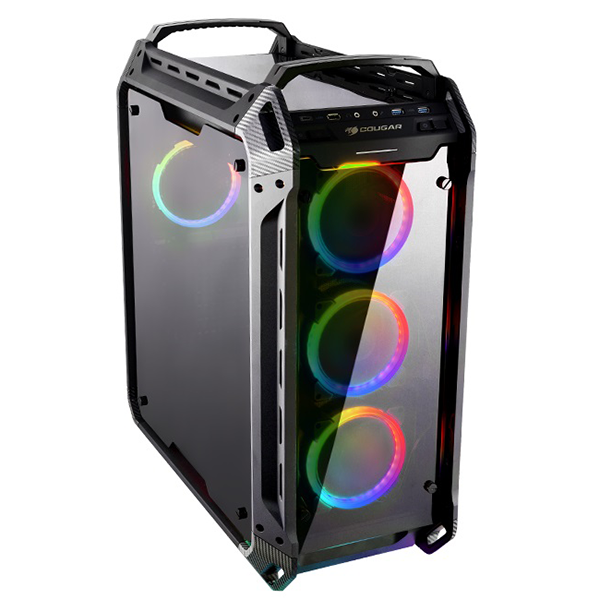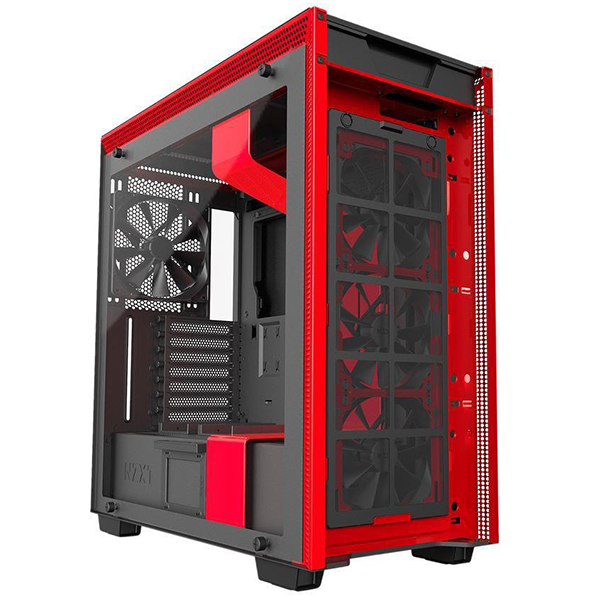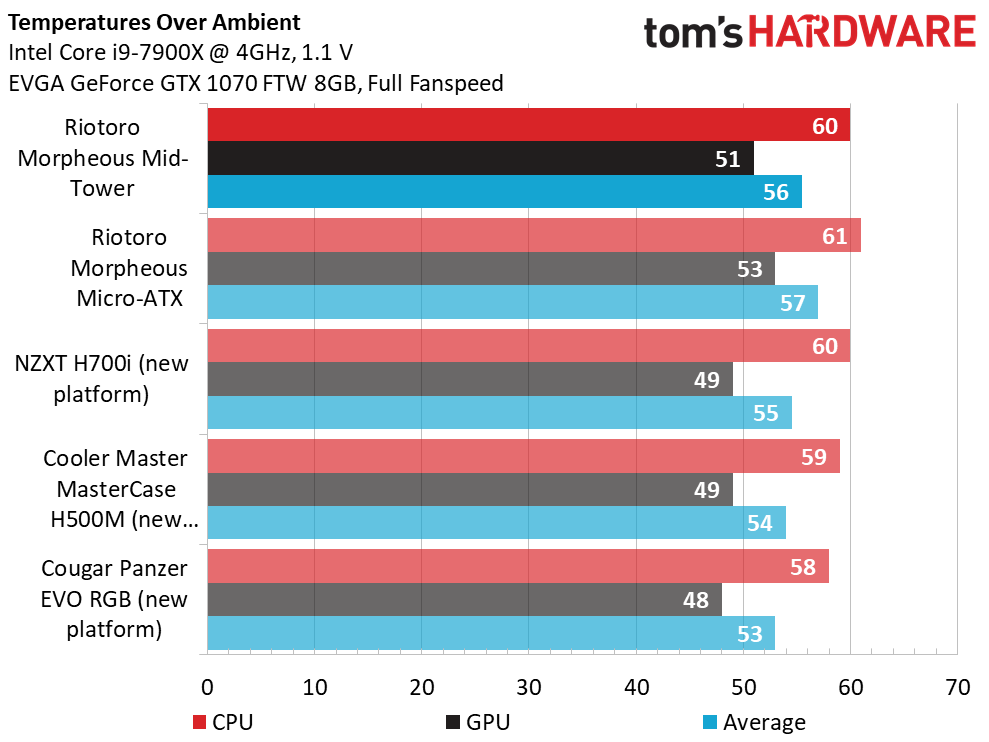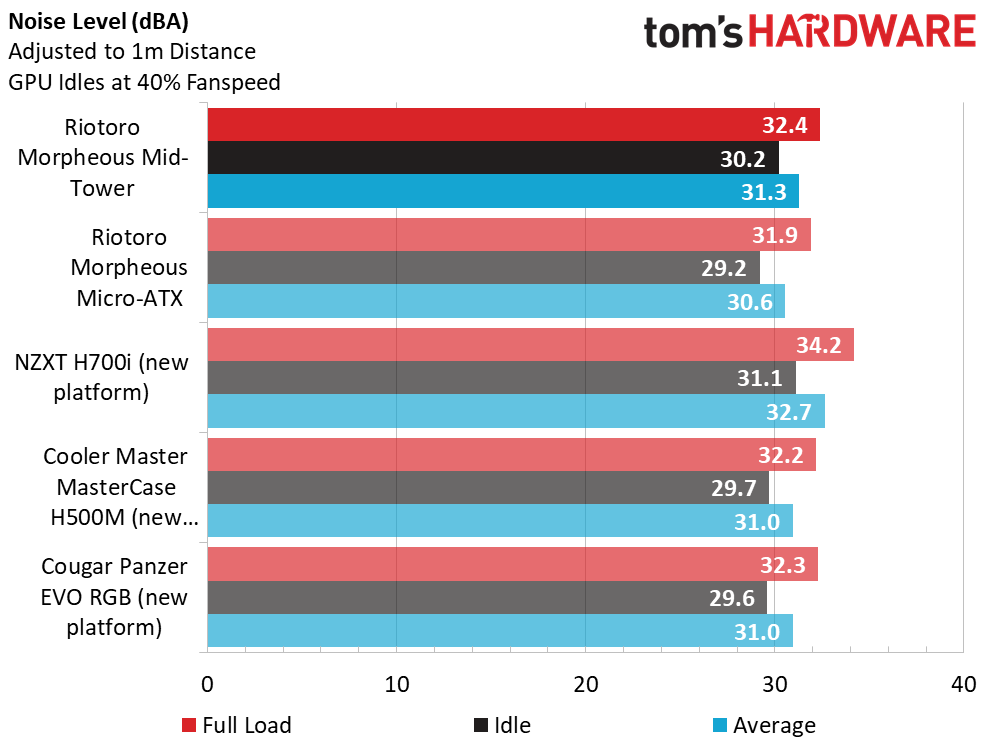Riotoro Morpheus GPX-100 Review: Forward-Looking Design, Some Assembly Required
Why you can trust Tom's Hardware
Benchmark Results and Conclusion
We tested the Riotoro Morpheus with our new Intel i9-7900X test platform. For comparison, we used the be Cooler Master MasterCase H500M, Cougar Panzer EVO RGB and NZXT H700i to give you a good idea where this case stands against others that are of similar size, feature sets, and price.
CPU core temperatures on our Intel i9-7900X processor running at 4GHz were very good considering the sheer amount of heat this processor is capable of generating under load. Given that the chassis is one big dual-compartment metal mesh box, we were not surprised to see the Morpheus turn in numbers neck-in-neck with the competition. We set intake fans speeds at max (1400RPM). For our first round of testing, the case was configured as a mid-tower and, under load, our processor temps held steady at 60°C over the ambient temperature of 25°C (77°F). In mini-tower form, processor temperatures rose by only 1°C (1.8°F).
GPU temps basically mirrored what we saw with CPU temps. Mid-tower temps peaked at 51°C over the ambient temperature with a 2°C increased in mini-tower form. That’s admirable performance given the high level of competition here. No doubt the sheer amount of airflow helped this chassis. Wiith its two 120mm intake fans and a single 80mm exhaust,results are right in line with other high end chassis with more and larger fans.
We took sound level readings with two off-the-shelf dB meters from two different angles. The case registered 29.5dB at idle and 32.4dB under load as a mid-tower and 29.2dB at idle and 31.9dB under load as a mini-tower. We were a bit surprised that, given the fact the Morpheus is fitted with metal mesh panels on all sides, the chassis turned in as good or better acoustic performance than the other cases we used for comparison.
Cooling efficiency and noise levels are both ways to measure performance. Determining acoustic efficiency, also referred to as "cooling-to-noise ratio," is a matter of averaging all five of our tests to determine a base value.
Bottom Line
If you have plans to make substantial upgrades your system in the future, the Riotoro Morpheus belongs on your short list. It delivers true E-ATX motherboard support, USB 3.1 Gen 2 Type-C, and cooling and acoustic performance that is on par with the best alternatives. This chassis fits the needs of gamers and enthusiasts alike.
Although assembly is required, you shouldn't let that stop you from buying this chassis. Normally we like to suggest alternative products at this point but, as far as we know, this is the only case on the planet that allows you to convert your system from mini-tower to mid-tower and back again for the same price you'd pay for other premium chassis.
Get Tom's Hardware's best news and in-depth reviews, straight to your inbox.
MORE: Best Cases
MORE: All Case Content
Current page: Benchmark Results and Conclusion
Prev Page Hardware Installation and Test ConfigurationSteven Lynch is a contributor for Tom’s Hardware, primarily covering case reviews and news.
-
mikewinddale If the entire case is perforated, then I'm worried about how effective the dust filters. Having positive air pressure in this case seems absolutely essentially.Reply -
nitrium Meh, I'll stick with my NZXT S340 (still among the best cases for the $$$ imo, despite being 2015 designed).Reply -
stevenlynch As noted in the review, the dust filters work great and are easy to clean. Also, the system noise was in line with all the other cases we tested against.Reply -
Mpablo87 Looks Great.Reply
Good article, useful information, Riotous morphed can help,thanks.
Reasonable Price!! -
jasonsrevell Is the difference between a mini and a mid tower only two inches normally? That's the difference in the dims listed here between the two. Maybe it's on the large side for a mini or smaller side for a mid?Reply -
stevenlynch @jasonsrevell you are correct on both counts. The chassis is a little big for a mini, a little small (outward dimensions) for a mid-tower. It is the perfect blend between the two.Reply





